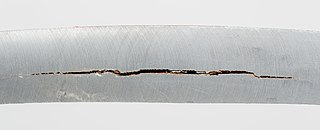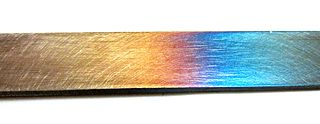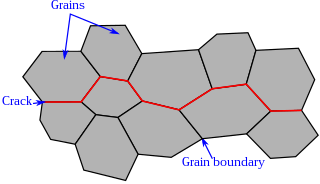
Corrosion is a natural process that converts a refined metal into a more chemically stable oxide. It is the gradual destruction of materials by chemical or electrochemical reaction with their environment. Corrosion engineering is the field dedicated to controlling and preventing corrosion.
Cupronickel or copper-nickel (CuNi) is an alloy of copper that contains nickel and strengthening elements, such as iron and manganese. The copper content typically varies from 60 to 90 percent.

Brazing is a metal-joining process in which two or more metal items are joined together by melting and flowing a filler metal into the joint, with the filler metal having a lower melting point than the adjoining metal.

Hydrogen embrittlement (HE), also known as hydrogen-assisted cracking or hydrogen-induced cracking (HIC), is a reduction in the ductility of a metal due to absorbed hydrogen. Hydrogen atoms are small and can permeate solid metals. Once absorbed, hydrogen lowers the stress required for cracks in the metal to initiate and propagate, resulting in embrittlement. Hydrogen embrittlement occurs most notably in steels, as well as in iron, nickel, titanium, cobalt, and their alloys. Copper, aluminium, and stainless steels are less susceptible to hydrogen embrittlement.

Tempering is a process of heat treating, which is used to increase the toughness of iron-based alloys. Tempering is usually performed after hardening, to reduce some of the excess hardness, and is done by heating the metal to some temperature below the critical point for a certain period of time, then allowing it to cool in still air. The exact temperature determines the amount of hardness removed, and depends on both the specific composition of the alloy and on the desired properties in the finished product. For instance, very hard tools are often tempered at low temperatures, while springs are tempered at much higher temperatures.

In materials science and solid mechanics, residual stresses are stresses that remain in a solid material after the original cause of the stresses has been removed. Residual stress may be desirable or undesirable. For example, laser peening imparts deep beneficial compressive residual stresses into metal components such as turbine engine fan blades, and it is used in toughened glass to allow for large, thin, crack- and scratch-resistant glass displays on smartphones. However, unintended residual stress in a designed structure may cause it to fail prematurely.

A reactor pressure vessel (RPV) in a nuclear power plant is the pressure vessel containing the nuclear reactor coolant, core shroud, and the reactor core.
Zirconium alloys are solid solutions of zirconium or other metals, a common subgroup having the trade mark Zircaloy. Zirconium has very low absorption cross-section of thermal neutrons, high hardness, ductility and corrosion resistance. One of the main uses of zirconium alloys is in nuclear technology, as cladding of fuel rods in nuclear reactors, especially water reactors. A typical composition of nuclear-grade zirconium alloys is more than 95 weight percent zirconium and less than 2% of tin, niobium, iron, chromium, nickel and other metals, which are added to improve mechanical properties and corrosion resistance.

Stress corrosion cracking (SCC) is the growth of crack formation in a corrosive environment. It can lead to unexpected and sudden failure of normally ductile metal alloys subjected to a tensile stress, especially at elevated temperature. SCC is highly chemically specific in that certain alloys are likely to undergo SCC only when exposed to a small number of chemical environments. The chemical environment that causes SCC for a given alloy is often one which is only mildly corrosive to the metal. Hence, metal parts with severe SCC can appear bright and shiny, while being filled with microscopic cracks. This factor makes it common for SCC to go undetected prior to failure. SCC often progresses rapidly, and is more common among alloys than pure metals. The specific environment is of crucial importance, and only very small concentrations of certain highly active chemicals are needed to produce catastrophic cracking, often leading to devastating and unexpected failure.

Intergranular fracture, intergranular cracking or intergranular embrittlement occurs when a crack propagates along the grain boundaries of a material, usually when these grain boundaries are weakened. The more commonly seen transgranular fracture, occurs when the crack grows through the material grains. As an analogy, in a wall of bricks, intergranular fracture would correspond to a fracture that takes place in the mortar that keeps the bricks together.
In materials science, environmental stress fracture or environment assisted fracture is the generic name given to premature failure under the influence of tensile stresses and harmful environments of materials such as metals and alloys, composites, plastics and ceramics.
Liquid metal embrittlement (LME), also known as liquid metal induced embrittlement, is a phenomenon of practical importance, where certain ductile metals experience drastic loss in tensile ductility or undergo brittle fracture when exposed to specific liquid metals. Generally, a tensile stress, either externally applied or internally present, is needed to induce embrittlement. Exceptions to this rule have been observed, as in the case of aluminium in the presence of liquid gallium. This phenomenon has been studied since the beginning of the 20th century. Many of its phenomenological characteristics are known and several mechanisms have been proposed to explain it. The practical significance of liquid metal embrittlement is revealed by the observation that several steels experience ductility losses and cracking during hot-dip galvanizing or during subsequent fabrication. Cracking can occur catastrophically and very high crack growth rates have been measured.

Embrittlement is a significant decrease of ductility of a material, which makes the material brittle. Embrittlement is used to describe any phenomena where the environment compromises a stressed material's mechanical performance, such as temperature or environmental composition. This is oftentimes undesirable as brittle fracture occurs quicker and can much more easily propagate than ductile fracture, leading to complete failure of the equipment. Various materials have different mechanisms of embrittlement, therefore it can manifest in a variety of ways, from slow crack growth to a reduction of tensile ductility and toughness.
Radiation damage is the effect of ionizing radiation on physical objects including non-living structural materials. It can be either detrimental or beneficial for materials.
Low hydrogen annealing, commonly known as "baking" is a heat treatment in metallurgy for the reduction or elimination of hydrogen in a material to prevent hydrogen embrittlement. Hydrogen embrittlement is the hydrogen-induced cracking of metals, particularly steel which results in degraded mechanical properties such as plasticity, ductility and fracture toughness at low temperature. Low hydrogen annealing is called a de-embrittlement process. Low hydrogen annealing is an effective method compared to alternatives such as electroplating the material with zinc to provide a barrier for hydrogen ingress which results in coating defects.
In metalworking, a welding defect is any flaw that compromises the usefulness of a weldment. There is a great variety of welding defects. Welding imperfections are classified according to ISO 6520, while their acceptable limits are specified in ISO 5817 and ISO 10042.
On July 23, 1984, an explosion and fire took place at a Union Oil petroleum refinery in Romeoville, Illinois, outside Chicago, killing 17 people and causing major property damage. The explosive force propelled the upper portion 14 metres (46 ft) of the vessel a distance of 1 kilometre (0.62 mi) from its original location, while the base remained at the center of the resultant fire.

HY-80 is a high-tensile, high yield strength, low alloy steel. It was developed for use in naval applications, specifically the development of pressure hulls for the US nuclear submarine program and is still currently used in many naval applications. It is valued for its strength to weight ratio.
High temperature hydrogen attack (HTHA), also called hot hydrogen attack or methane reaction, is a problem which concerns steels operating at elevated temperatures in hydrogen-rich atmospheres, such as refineries, petrochemical and other chemical facilities and, possibly, high pressure steam boilers. It is not to be confused with hydrogen embrittlement.
Metal-induced embrittlement (MIE) is the embrittlement caused by diffusion of metal, either solid or liquid, into the base material. Metal induced embrittlement occurs when metals are in contact with low-melting point metals while under tensile stress. The embrittler can be either solid (SMIE) or liquid. Under sufficient tensile stress, MIE failure occurs instantaneously at temperatures just above melting point. For temperatures below the melting temperature of the embrittler, solid-state diffusion is the main transport mechanism. This occurs in the following ways:









